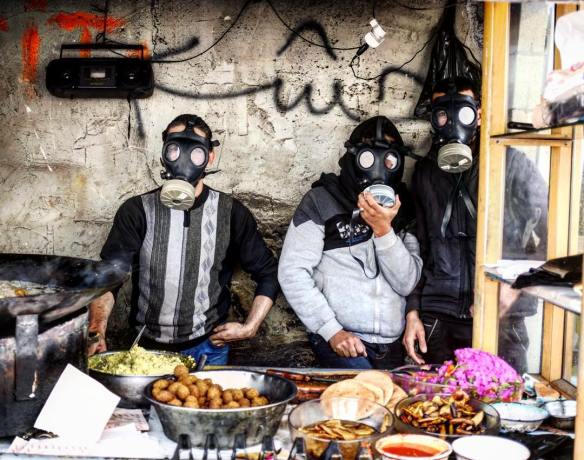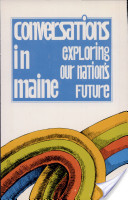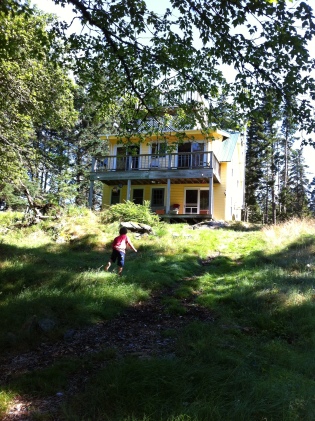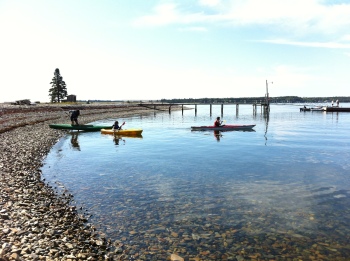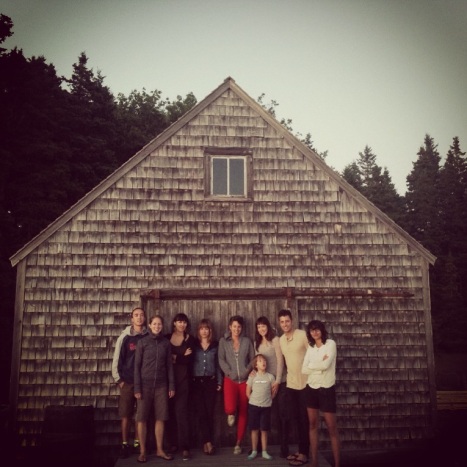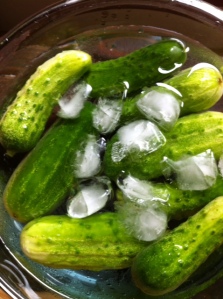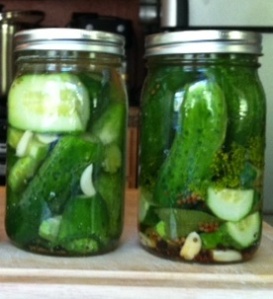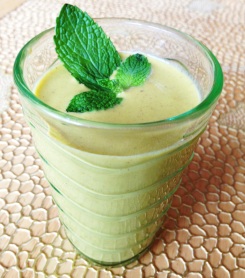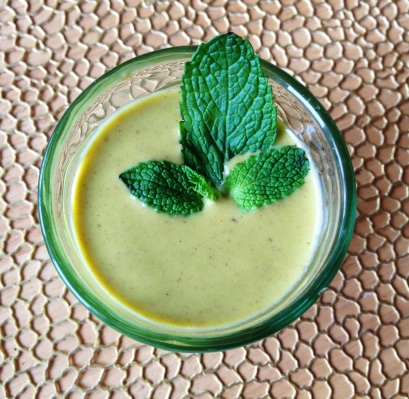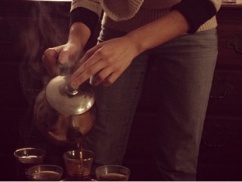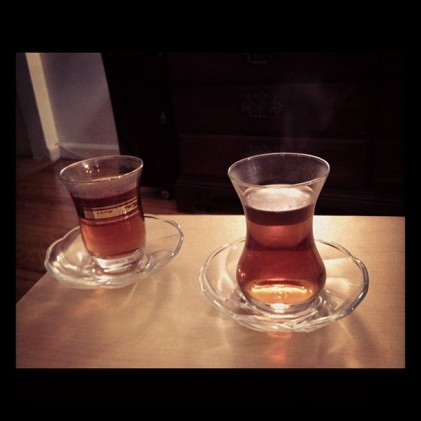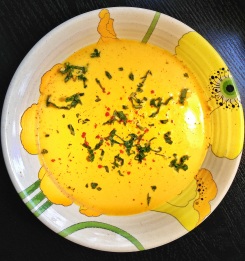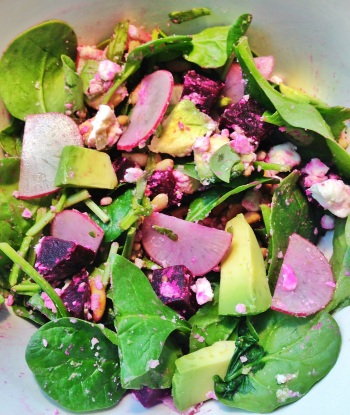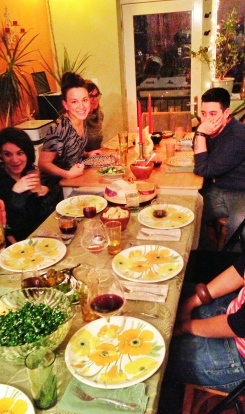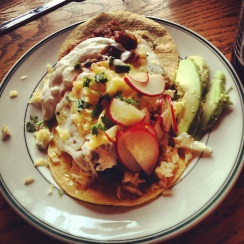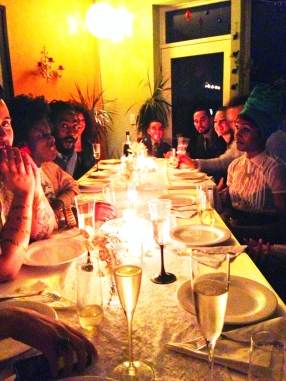Recently I’ve stepped away from the work I was doing as part of the movement for justice in Palestine. In the meantime, I’ve been nurturing my passion for food- reading, cooking, gardening, organizing cooperative culinary events, and slowly (like really slowly) building this blog. Thus the publishing of Jerusalem: A Cookbook by Yotam Ottolenghi and Sami Tamimi, provided a provocative opportunity for me to explore the connections on a very real level. And I explore them at great length here. (Reading this in installments might be recommended for those of you who share my short attention span. Sorry. There’s just so much to say).
****
I was born in Jerusalem. I have spoken these words a million times- in English, Hebrew, and Arabic. It pretty much never fails to elicit a response (raised eyebrows and big smile accompanied by an auditory signal of excitement and/or respect, such as “OOOOOH” or “COOOOL”). Almost anyone I am speaking to has some dramatic association with Jerusalem.
****
I was born in the Israeli hospital Hadassah Ein Karem. It was early March and my mother loves to tell me that the almond trees were blooming while she made her way to give birth to me.
Several years ago, I met a young person in a refugee camp in Bethlehem who told me his family is originally from the Palestinian village of Ayn Karim to which they have not been allowed to return. When I told him that I was born in the Jewish hospital that now stands on part of his village’s lands, he smiled warmly. I cried and tried not to make a spectacle of it.
****
Ten years ago I wrote and performed one spoken word piece over and over again in cities across the country. There was no impressive word play, it was not great poetry- it was just simply true and people needed and wanted to hear it from a young American Jew at that time. Risking deep embarrassment, I revisited the poem as part of an exercise in thinking about Jerusalem and why I might dare to comment on the most recent gorgeous and impeccably put together cookbook from Ottolenghi and Tamimi. I actually have to admit that I stand by the sentiment of my 22-year-old self still and find it relevant as I insert myself into this conversation. I voiced my connection to the hills of Jerusalem, the shores of the Mediterranean, the closeness of the desert, the clamor of the shuk. I rejected the need to own this powerful place and instead committed to its preservation. I recognized Israeli attempts at being Western destroying the aesthetics of ancient cities and the customs of Arab Jews and Palestinians being suppressed and redressed for my pleasure.
I was calling out the destruction and cruelty I was witnessing while acknowledging the deep love and familiarity I felt confusingly close beneath the horror whenever I returned there. I hadn’t stopped craving the parts of the land and culture that I had loved while living there. I still can go to town on a falafel sandwich wrapped in large warm laffa bread, with hot red pepper sauce, tahini, and hummus oozing out between chunks of fried eggplant and too many pickles to really fit. I still can be seduced by a tranquil courtyard at night with jasmine blossoms infusing the warm air and lights casting dramatic shadows on the ancient stone buildings and streets…It is not that I am immune to the magic of being somewhere that is SO OLD and has so many cultures, so many histories, so many layers and languages….No- rather, it is exactly that enchantment that makes my heart break seeing the people, languages, foods, buildings, plants, and traditions that enchant me so much being co opted, destroyed, and displaced.
So I’m no stranger to the complex romance of Jerusalem (in Arabic, Al Quds). Although I actually haven’t been back there in 4 years and haven’t written or talked about this in a while. I have to admit I feel disconcerted, although not surprised, by the nagging nostalgia that this writing process has awoken in me for a place where olive oil, lots of lemon, fresh almonds plucked from trees, warm soft flat breads, jasmine, and bougainvillea infuse everyday life…because now undermining and surrounding these are demolition, religious control, ethnic cleansing, and other less romantic forces at play.
****
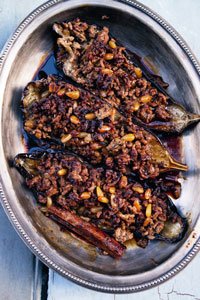
Stuffed Eggplant from Jerusalem
The recipes in Jerusalem are, as usual with Ottolenghi, impeccable. The meals they produce are full of bright, well balanced flavors and colors in just the right proportions. The photography is gorgeous. It serves a refreshing combination of poetic passion for the food, a deep respect and understanding of special spices and vegetables, thoroughly researched and organized information, and a delightful playfulness. My love for their approach is exemplified in their reference to eggplant as a “little local celebrity.”
The main problem is a depoliticized celebration of the richness of the city’s heritage and the diversity of the cuisine. They simply do not address how seriously the communities, places, and food traditions from which the recipes are drawn, are suffering and disappearing because of government policies. It is not just a matter of bad attitudes or unfortunate frivolous squabbles between neighbors as their introduction would have you believe.
The introduction to Jerusalem states that “the dialogue between Jews and Arabs, and often among Jews themselves, is almost nonexistent. It is sad to note how little daily interaction there is between communities, with people sticking together in closed, homogenous groups.” They point out that it is a rare occasion that people from different communities there work together. I know that the systems that have been put in place to ensure this segregation have not escaped these native Jerusalemites’ observation so I’m disappointed that they mentioned this reality as if it were just a bewildering cultural phenomenon. A giant militarized concrete wall literally caging entire communities of Palestinians and more than 50 laws that discriminate against Palestinians in every aspect of life, have created the separation Ottolenghi and Tamimi refer to. Although they neglect to report these reasons for the segregation, they at least include this small acknowledgement of the power imbalance: “Intolerance and trampling over other people’s basic rights are routine in this city. Currently, the Palestinian minority bears the brunt with no sign of it regaining control over its destiny, while the secular Jews are seeing their way of life being gradually marginalized by a growing Orthodox population.”
****
Although Tamimi is listed as an author, the voice of this book reads as predominantly Jewish Israeli. Albeit a Jewish Israeli perspective that provides much more acknowledgement of Palestinian and Arab culture than the average Jewish publication. (Which is not saying much given that mainstream Jewish media treats the word “Palestinian” like an evil spell that will magically and immediately erase the state of Israel if uttered). Still, sometimes subtly and sometimes blatantly, this book articulates a Jewish perspective on the history and current culture of Jerusalem. This can be most clearly seen in the summary of the history of the city, which presents Jewish mythology as factual history while presenting Palestinian historical experiences as mere “claims”.
Notice the effect of the different word choices here: “When King David founded [Jerusalem] as his capital…David was a warrior and chose his capital for strategic reasons”….versus “some Palestinians claim that they are descendants of the Jebusites, the original inhabitants of Jerusalem, who were deposed by King David.” The tone of the former is definitive, the tone of the latter is questioning.
If the same treatment was being delivered to Palestinian as well as Jewish viewpoints in this book, the destruction of the second Temple which is referred to as “painfully etched in Jewish history as the onset of a slow process of decline that would not end until the advent of Zionism,” would have read more like “some Jews claim the decline ended after the advent of Zionism”. This framework would be one within which Israeli Jewish narratives are also acknowledged as fraught and constructed while avoiding the erroneous assumption of a monolithic Jewish view given the broad spectrum of (often troubled) relationships to Zionism and Israel amongst Jews themselves, not to mention Palestinians.
****
I find the avoidant attitude assumed towards the question of culinary ownership the most disappointing and frustrating given the careful consideration of the sources and stories behind all of the recipes. Ottolenghi/Tamimi’s reference to the question of ownership is flippant and dismissive, trying to sidestep an issue that is actually at the heart of any culinary exploration of Jerusalem but that they may fear would affect their large sales if things got too heated perhaps…?
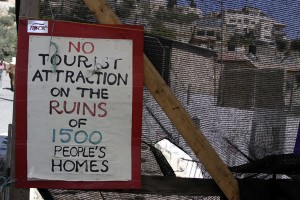
Silwan, a Palestinian neighborhood in Jerusalem
Ownership is a real issue in Palestine/Israel- not just a rhetorical question. Israeli archaeological efforts on historical sites are blatantly aimed at undermining Palestinians’ claim to their own homeland and displacing their communities; and Palestinian farmers are attacked by Israeli settlers while trying to harvest olives from their groves in the fall (while olives and olive branches remain a symbol of peace in Jewish culture)….these are not just silly ego battles, these are life or death struggles for ownership on very serious levels.
It is simply wrong for Ottolenghi and Tamimi to publish a book that begins by saying where these cuisines come from and to whom they belong doesn’t matter. I completely agree with their assertion that the beauty of food is indeed in the “sensuality and pleasure of the moment” but it is also equally found in the stories, wisdom, and customs passed down from generation to generation, connecting us through that sensual moment to all of these past people and times. Ottolenghi and Tamimi, of all people, should know that.
To say the beauty of food is that it is rooted in the now (which is what they put forth) seems out of line with a true appreciation of culinary art which is, when it comes down to it, about deriving beauty from the balancing relationship between accumulated wisdom and individual innovation. The thoroughly researched recipes themselves in the pages that follow belie this wishy-washy position they take in the introduction. Throughout the book they acknowledge the impact of history and socioeconomic context on a cuisine. They offer the background on bulgur as a grain that historically has been a rural people’s food while remembering how rice was the affluent urban grain. They brilliantly observe that the predominance within Jerusalem’s cuisine of laborious preparations involving stuffing things indicates the history of a community that was “time rich and resource poor”. They acknowledge the influence of Italian cooking on Libyan cuisine via their colonization of that land….and so on and so forth.
Despite this apparent respect for the origins of certain recipes, they oversimplify the debate surrounding hummus. Attempting to prove that hummus cannot be “owned”, they miss the point entirely. By pointing to the existence of hummus in the traditional cuisine of the Jews of Aleppo they are actually highlighting the core issues on the table- the cooptation of Arab culture (which includes Jews). Hummus is indeed a longtime staple of Aleppine Jews as well as Palestinians and other Arabs…that is actually not the question.
What hummus is NOT, is a dish that belongs to the modern state of Israel claiming it as its national food while historically marginalizing both the Arab Jews and the Palestinian Arabs who introduced it to the European immigrants who hold most of the positions of power in Israeli society and who dominate the construction of its national identity. The cooptation of hummus and other Arab foods is not really surprising or different than how things go down in any other settler-colonial country. The recipe: take the desirable music, food, clothing and mix together, discard as many of the undesirable people as possible.
Thinking about all of this right now from my position in Brooklyn, I am interested to see how the current Mediterranean food trend amongst the popular restaurants of New York City plays out.
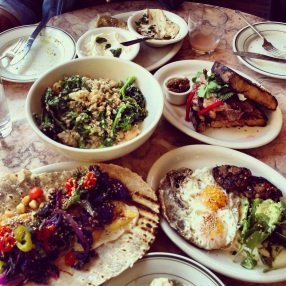
(delicious!) brunch at Glasserie in Brooklyn, including Middle Eastern ingredients such as merguez, bulghur, za’atar, “flakey bread”, and labneh
In this anti-Arab and Islamaphobic society obsessed with the horror of al Qaeda and making movies about the war against jihadists, apparently shwarma, zaatar, and grilled lamb are allowed past the borders. As long as they are served by white people. But then again, that’s how this country likes its hip hop, ramen, tacos, and Harlem Shake. So its par for the course.

Frame from “Planet of the Arabs” by Jacqueline Reem Salloum
Without discussing the real issues in the place from which these recipes are being adapted, what Ottolenghi and Tamimi are doing is familiarizing Western audiences with these Middle Eastern delights without mobilizing people to preserve the origins of this cuisine they’re celebrating (and making a living off of). Soleil Ho’s break down of #foodgentrification is powerfully relevant here, as Ho focuses on the issues experienced by the marginalized communities whose foods come into the spotlight of the industry: “fear of being unable to feed one’s family, of losing access to traditional foods, of being priced out of toxin-free produce, of one’s food being alternately shamed and fetishized depending on commercial whims, of having one’s history repackaged and sold.”
****
Jerusalem successfully delivers a romanticized image of a place in which the mixing and coexisting that it refers to as such a treasure and obviously generative of amazing food, amongst other cultural creations, is actually under attack by the Israeli government through its relentless ethnic cleansing policies. Entire neighborhoods have been destroyed and populations criminalized and displaced- Arab Jews and Palestinian Arabs at different times and in different ways.
As we Westerners all enjoy reading the rich recipes and cooking festive meals from the Jerusalem cookbook, this is what is happening in that much romanticized city:
Tayma lives in the Palestinian neighborhood of Silwan on the outskirts of Jerusalem’s Old City. Israeli authorities issued many of the Palestinian families living in Silwan with demolition orders for their homes to clear the area for a national park.
Israeli authorities also approved a large tourism center in the heart of the neighborhood, which will include parking, an event hall, a cafeteria, and stores. They’ve handed development of the area to Elad, an Israeli settlement organization.
“All the houses here are under threat of demolition [by Israel] so that the settlers can build a park for their children,” says Tayma. “They want to throw Palestinian families on the streets so that they can build parks for their own children.”
Israeli settlers have moved into Silwan. With the aid of Israeli security forces, they subject the longtime Palestinian residents to daily violent harassment and intimidation.
From Electronic Intifada
****
In an interview for Haaretz in January, Ottolenghi and Tamimi acknowledged some of the inequities in their creative/culinary partnership- the underbelly of their beautiful team. While they were working on the cookbook, Ottolenghi and Tamimi were asked to take part in a BBC documentary to be shot while they visited their shared hometown. Tamimi’s passport had expired during the 9 years he did not return because he was too traumatized by his treatment entering and leaving the country. He experienced humiliating and frustrating bureaucratic discrimination throughout the renewal process and ended up unable to return to his birthplace.
Ottolenghi went without Tamimi and the BBC cameras followed only Ottolenghi around Jerusalem. The fact that Ottolenghi went without Tamimi confuses me, as he articulates in the Haaretz interview a perfect understanding of the underlying issues: “We were born in the same city and in the same year, and our parallel existence is the background to the emergence of our friendship and partnership, and to the book about Jerusalem. A blow like this reminds us that even if everything looks good on the surface, the fact is there is one law for me and another for him”.
It’s actually a crystal clear example of the more meta issues of who gets to transcend boundaries and tell the stories- through whose eyes do we see the city of Jerusalem and the land it is a part of? I have no doubt that Ottolenghi and Tamimi’s partnership has been incredibly fulfilling (and lucrative) for both of them and it is not my place to question the strong bond they represent themselves as having. I have no idea what the decision-making process was for this trip but I do wonder why Ottolenghi didn’t say “NO- I am not going without my co-author and partner in this”. I wonder about how powerful that could have been- for this very high profile Jewish Israeli to take a principled stand against the unequal treatment he and his Palestinian partner were receiving and refuse to cash in on his privilege. This is the kind of action and relatively small sacrifice that we need those who are as secure in their finances and career as Ottolenghi is to make. People with less security and resources make those kinds of sacrifices all of the time.
“It’s like having cold water poured on you,” Tamimi said. “We recently returned from a book-promotion tour in North America. Many of the events were with Jewish communities. We spoke endlessly about Israel, about Jerusalem and about coexistence − and then you get a slap in the face like this.” Exactly! The truth is that you can have a couple of handsome men speaking in English, one Israeli and one Palestinian, serve the colorful cuisine in sexy white linen dining rooms in London and multicultural events in the U.S., and even Jewish communities who are very defensive in the face of any mention of Palestine or Palestinians can digest it because it’s not connected to any real conversation about what’s really happening in Jerusalem. So how do Ottolenghi and Tamimi feel satisfied with their cookbook? No matter how delicious the recipes are when I make them, and no matter how compelling their descriptions are of the ingredients and the stories of the recipes, I am left feeling like there are major ingredients missing. And yes Ottolenghi and Tamimi successfully deliver amazing and delicious food that unfamiliar cooks and eaters will learn from, be inspired by, and develop a love for…but what does the cookbook do to preserve the original cooks and eaters of this cuisine? As such passionate and wise gourmands as Ottolenghi and Tamimi are, they must care more about preserving the original community food traditions than their cookbook implies.
****
I’ve come to realize that the passion and depth of emotion I feel connected to food flows from the power of its intersectionality. I believe that Ottolenghi and Tamimi’s excitement about cooking is rooted in a similar awareness of the power of food to connect people- to their own bodies, to creativity, to each other, to history, to the land, the seasons, animals and plants, family stories….Food is the only concrete connection between urban and rural worlds, between city dwelling cooks and eaters and the farmers producing their ingredients. Cuisine is often the only interaction people have with cultures outside of their own. Restaurants are the intersection where wealthy people who have the means to eat out, sit under the same roof as some of the poorest laborers working 14 hour days in the kitchens serving them.
SO…we need to respect and channel that power of food and allow the recipes in Jerusalem to be keys in our hands. They can help us connect to the communities from which these bright and bold flavors come- we can SEE the people, not just eat their food. Let the recipes be our guides to learning about what’s actually going on right now in the very real city of Jerusalem. If we value what the traditions and cultures of that place have brought into the world, let’s support their efforts to preserve themselves.
****
To learn about the spices, produce, meats, and meals of the same place in different contexts, I strongly suggest people pick up these two other fellow travelers’ cookbooks:
The Gaza Kitchen: A Culinary Journey Through the Gaza Strip
OLIVES, LEMONS & ZA’ATAR: The Best Middle Eastern Home Cooking
****
jerusalem sunday
by Suheir Hammad
jeru
salem
sun
day
three muezzins call idan
where one’s allah begins another’s
akbar ends inviting the last
to witness mohammad’s prophecies
church bells ring the sky
an ocean shade of blue above
christ’s tomb and the stones
of this city witness man’s weakness
boys run by the torah
strapped to their third eye
ready to rock their prayers
the roofs of this city busy as the streets
the gods of this city crowded and proud
two blind and graying
arab men lead each other through
the old city surer of step than sight
tourists pick olives from the cracks
in the faces of young and graying
women selling mint onions and this
year’s oil slicking the ground
this city is wind
breathe it
sharp
this history is blood
swallow it
warm
this sunday is holy
be it
god
